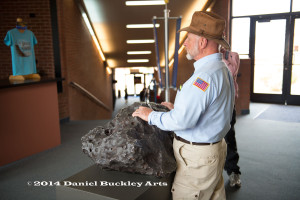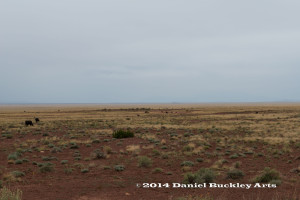Return to Meteor Crater – One small step for Dan
Click photos to enlarge
I found myself back at one of my sacred places yesterday morning – Meteor Crater, Arizona.
My whole childhood was about the dream of going to the moon. I was seven years old when Alan Shepard became America’s first astronaut, and nine when President John F. Kennedy set the goal of going to the moon by the close of the 1960s. My entire childhood was punctuated by the Mercury and Gemini programs which worked out the techniques the Apollo program would use to send astronauts to the moon. I knew I was too young to be part of the generation that left those first boot prints in the lunar dust, but hoped to be part of the next generation that would build telescopes and do geological work on our closest celestial neighbor.
Meteor Crater was a big part of my coming to Arizona in 1971, as was the University of Arizona’s Lunar and Planetary Laboratory. In the summer of 1972, as a young geology student, I traveled to Meteor Crater for the first time in search of shatter cones that were evidence of a meteor impact. By the end of that same year Apollo 17 astronauts Eugene Cernan and Jack Schmidtt (the first and only geologist astronaut) would be the last to walk the lunar surface to this day.
Now 42 years later I was back at Meteor Crater – a place that has changed little and greatly in the four decades since I first hobbled down the crater walls. Little change has occurred geologically speaking. It remains the best preserved evidence of a meteor impact on the planet. But as a destination for broad educational possibilities, Meteor Crater is a whole different world altogether. Incredibly knowledgeable tour guides explain the history of the crater and the path of its scientific unraveling to nearly a quarter of a million visitors a year. Various observation platforms give visitors a perspective few ever got to see before. And the museum fills in the blanks.
This time I was back with a camera intent not on searching for evidence of the impact that created it, but evidence of the fantastic beauty of our world, the solar system and the universe we are part of. And I was also there to artistically reclaim my destiny in a new photographic series I am calling Apollo 18. The trip was just a quick look to get the lay of the land for the project, and the panoramic photos I took were more like the contingency sample of lunar soil Neil Armstrong scooped off within minutes of stepping off the landing pad onto the surface of the moon. His was a tiny sample in case they had to get back in the spacecraft and take off in an emergency. Mine was just something to grab quickly before the sky’s promise of rain became a reality.
Driving up the 6 miles of cattle country off Interstate 40 west of Winslow that lead to the crater brought back many memories, as did the drive from Flagstaff. Seeing the old Indian trading posts I visited long ago, now abandoned and covered in graffiti, was strange. Likewise passing the rubble of the “town” of Two Guns and the Mountain Lion tourist attraction at Canyon Diablo was surreal.
The low ominous clouds that dipped toward the landscape amplified the strange mood. But they also allowed me to photograph large panoramas in greater detail, unhampered by the sharp shadows the bright sun would normally have imposed. I’m hoping to get back up there this summer and start officially laying the groundwork for the project with the folks who manage the crater today. Hopeful as well to find funding for the project, which will also include a site around Sunset Crater, Arizona and one in New Mexico – all of them places where astronauts trained for moon landings in the ‘60s and early ‘70s.
But in the meantime, this was one small step.





